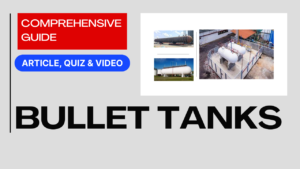Introduction
Gaskets are vital components in various industries, playing a crucial role in ensuring leak-free connections and maintaining the integrity of mechanical systems. This comprehensive guide explores the functions of gaskets, the different types available, and their applications across industries.
Table of Contents
Don’t miss the Complete Course on Piping Engineering: Check Now
By EPCLand.com
Understanding Gaskets: A Fundamental Overview
Gaskets are mechanical seals that fill the gap between two or more mating surfaces, preventing leaks by creating a tight and secure seal. These seals are commonly made from a variety of materials, each chosen based on factors such as temperature, pressure, and the type of fluid or gas being contained.
Functions of Gaskets
Gaskets serve several key functions in mechanical systems:
1. Sealing: The primary function of gaskets is to create a reliable seal between mating surfaces. This prevents leakage of fluids or gases, ensuring operational safety and efficiency.
2. Compensation for Surface Imperfections: Gaskets can compensate for irregularities and imperfections in mating surfaces, ensuring a tight seal even when surfaces aren’t perfectly smooth.
3. Vibration Dampening: Gaskets help absorb vibrations and shocks, reducing wear and tear on the components and prolonging the life of the machinery.
4. Temperature and Pressure Resistance: Gaskets are designed to withstand varying temperatures and pressures, maintaining their sealing capabilities even in extreme conditions.
5. Corrosion Protection: Gaskets can act as a barrier between different metals, preventing galvanic corrosion that can occur when dissimilar metals come into contact.
Types of Gaskets and Their Materials
Gaskets come in a range of types and materials, each suited for specific applications:
1. Compressed Fiber Gaskets
These gaskets are made from materials like cork, rubber, or paper fibers. They’re versatile and used in a wide range of applications, from automotive engines to plumbing systems.
2. Metal Gaskets
Metal gaskets, often made from materials like stainless steel or copper, are known for their durability and ability to handle high pressures and temperatures. They’re commonly used in industries such as oil and gas.
3. Ring Joint Gaskets
Ring joint gaskets are used in high-pressure applications, typically in the oil and gas industry. They’re designed to handle extreme conditions and provide a reliable seal.
4. Spiral Wound Gaskets
Spiral wound gaskets are made by winding a metal strip and a filler material, creating a strong and flexible seal. They’re used in applications involving high temperatures and pressures.
5. Rubber Gaskets
Rubber gaskets, often made from materials like neoprene or silicone, are known for their elasticity and resistance to various fluids. They’re used in industries such as food and pharmaceuticals.
Common Industrial Applications
Gaskets are integral components in various industries:
1. Automotive Industry
Gaskets are used in engines, transmissions, and exhaust systems, preventing leaks and ensuring optimal performance.
2. Oil and Gas Industry
The oil and gas sector relies on gaskets to maintain sealing integrity in pipelines, valves, and pressure vessels.
3. Chemical Industry
Gaskets play a role in preventing chemical leaks and ensuring safety in equipment used for chemical processing.
4. Food and Beverage Industry
Gaskets used in this industry must meet strict hygiene and FDA regulations, ensuring that the products are safe for consumption.
5. Aerospace Industry
In aerospace applications, gaskets are used in engines, fuel systems, and hydraulic systems to ensure safety and reliability.
FAQs
Q1: What is a gasket? A1: A gasket is a mechanical seal that creates a tight connection between two or more mating surfaces to prevent leaks.
Q2: What are the functions of gaskets? A2: Gaskets seal connections, compensate for surface imperfections, dampen vibrations, resist temperature and pressure, and protect against corrosion.
Q3: What are the different types of gaskets? A3: Common gasket types include compressed fiber gaskets, metal gaskets, ring joint gaskets, spiral wound gaskets, and rubber gaskets.
Q4: Where are gaskets used? A4: Gaskets are used in various industries, including automotive, oil and gas, chemical, food and beverage, and aerospace, to ensure leak-free connections.
Q5: How do I choose the right gasket material? A5: The choice of gasket material depends on factors like temperature, pressure, fluid or gas type, and application. Consulting with experts can help you make the right selection.
Conclusion
Gaskets are unsung heroes in the world of mechanical systems, ensuring leak-free connections and contributing to the safe and efficient operation of various industries. By understanding the functions, types, and materials of gaskets, professionals can make informed decisions that optimize the performance and reliability of their equipment. As industries continue to evolve, the role of gaskets remains paramount in maintaining the integrity of critical systems.
Recommended courses (Published on EPCLand)
- Basics of Piping Engineering
- Piping Layout Engineering
- Piping Material Engineering
- Piping Stress Analysis
- Complete Course on Piping Engineering
- Material Requisitions
- Piping Material Specifications
- Valve Material Specifications
Don’t miss the published articles on following:
Related Video
Attempt Quiz
Question 1:
What is the primary function of a gasket in a mechanical assembly?
Explanation: The primary function of a gasket is to create a seal between mating surfaces, preventing leakage of fluids or gases and maintaining a secure connection.
Question 2:
Which type of gasket is commonly used for high-temperature and high-pressure applications?
Explanation: Spiral-wound gaskets are commonly used for high-temperature and high-pressure applications due to their ability to withstand extreme conditions and provide effective sealing.
Question 3:
Which gasket material is suitable for applications involving strong acids and alkalis?
Explanation: PTFE (Teflon) is a gasket material known for its excellent chemical resistance, making it suitable for applications involving strong acids and alkalis.
Question 4:
What is the purpose of a gasket’s compressibility?
Explanation: The compressibility of a gasket allows it to conform to uneven mating surfaces, ensuring a tight and effective seal even in cases where the surfaces are not perfectly flat.
Question 5:
Which type of gasket is often used in flanged connections?
Explanation: O-ring gaskets are often used in flanged connections due to their circular cross-section and ability to provide reliable sealing in a variety of applications.



